News
‘RED ZONE – FREE THE ARTS’
is an international celebration of freedom of expression in art and culture, which will be held in Norway from 28 February to 3 March 2013

The famous Middle Eastern artists Tania Saleh, Rim Banna, Mohamad Abla and Syrian Bear Yumal are headlining the international culture-event ‘Red Zone’ which has Kulturkirken Jakob (‘Culture Church Jacob’) as its main stage from 28 February to 3 March. The event offers music, poetry, film, dance, performance art, installation art and other forms of visual art.
The title ‘Free the arts’ indicates that the organisers, Kirkelig Kulturverksted and Kulturkirken Jakob, want to put freedom of expression through art on the agenda.
“Art has a different and perhaps deeper way of describing and understanding reality than the often simplified and one-sided formulas of the news media. We have no real freedom of expression if artists don’t have the freedom to express themselves as they want to, and if they don’t have an arena and an open channel to reach a broad audience. This is a challenge, not only in countries that have a general problem with freedom of expression. It is also an issue in Western democracies,” says Erik Hillestad, the head of Kirkelig Kulturverksted.
Programme
The opening show “Red zone performance” on Thursday 28 February will feature an array of expressive forms under the direction of Kate Pendry and Erik Hillestad. Featured performers include Syrian Bear Yumal, Iranian Mahsa Vahdat, Vietnamese performance artist Luong Tran and Egyptian painter Mohamad Abla, along with authors Walid Al Kubaisi and Håvard Rem, actress Kate Pendry and installation artist Morten Viskum. Together they will demonstrate some of the conditions for freedom of expression across national borders and political systems.
On Saturday 2 March, the award-winning Iranian film ‘Parviz’ will be shown for the first time in Norway, and Majid Barzegar, the director, will attend the showing and will discuss the film afterwards.
On Sunday 3 March, the annual and global Music Freedom Day, a concert will be given featuring Tania Saleh (Lebanon), Rim Banna (Palestine) and Bugge Wesseltoft (Norway), Toot Ard (Golan heights) and Checkpoint303 (Palestine and Tunisia).
Throughout the cultural festival the exhibition ‘Images in times of rebellion’ by Egyptian visual artist Mohamad Abla will be on show in Jakobs Brønn (the church cellar).
The dance performance ‘Open for everything’ by Constanza Macras – a celebration of the songs, dance and music of the Roma people – will be given on 1, 2 and 3 March in Dansens Hus.
Participating artists:
Mahsa Vahdat (Iran)
Mohamed Abla (Egypt)
Håvard Rem (Norway)
Walid Al Kubaisi (Norway)
Kate Pendry (Norway)
Syrian Bear (Syria)
Morten Viskum (Norway)
Luong Tran (Vietnam)
Dance performance of Dorky Park / Constanza Marcas (Germany)
Majid Barzegar (Iran)
Tania Saleh with band (Lebanon)
Checkpoint 303 (Palestine and Tunisia)
Toot Ard (Golan Heights)
Rim Banna (Palestine)
Bugge Wesseltoft (Norway)
Organisers and sponsors
‘Red Zone’ is funded by the Norwegian Ministry of Foreign Affairs, Fritt Ord (the Norwegian Freedom of Expression Foundation which also sponsored artsfreedom.org) and Arts Council Norway.
Kirkelig Kulturverksted and Kulturkirken Jakob announced already in June 2012 that they had received support enabling them to organise an annual manifestation for freedom of expression in art, and that this will be linked to the Music Freedom Day in early March 2013. A programme council was formed to guide the project staff, consisting of the following members:
Walid Al Kubaisi, author
Nina Witoszek, professor
Nina Zandjani, translator
Kate Pendry, actor and director
Sigbjørn Nedland, programme director
Cato Litangen, general manager
John Peder Egenæs, general secretary
Erik Hillestad, general manager and producer
Morten Eriksen, consultant
Read more on red-zone.no
Sous nos yeux (partie 1)
[Before Our Eyes (part 1)]
Kunsthalle Mulhouse
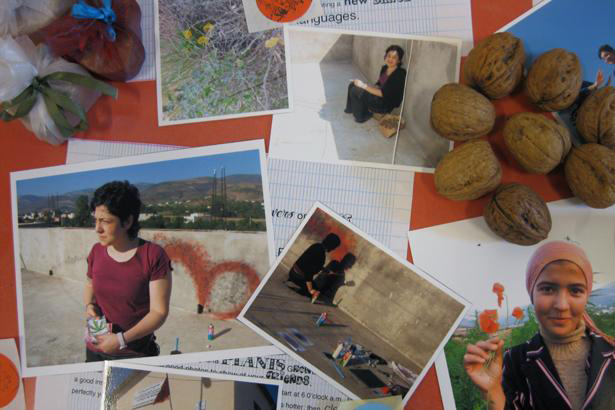
Sous nos yeux (partie 1)
[Before Our Eyes (part 1)]
Group exhibition, radio program, encounters and dialogues at La Kunsthalle Mulhouse.
This program opens the first series of events of the multistage project Sous nos yeux.
February 14–April 28, 2013
Opening: Wednesday, February 13, 6pm
La Kunsthalle Mulhouse / La Fonderie
16 rue de la Fonderie
68093 Mulhouse Cedex, France
T +33 (0)3 69 77 66 47
This e-mail address is being protected from spambots. You need JavaScript enabled to view it
Curated by Abdellah Karroum*
Sous nos yeux (partie 1)
Sous nos yeux is a group project inaugurated at La Kunsthalle Mulhouse. It features works by Adel Abdessemed, Gabriella Ciancimino, Badr El Hammami, Pedro Gómez-Egaña and Younès Rahmoun, and an intervention by the group LMPD (l’autre moitié du paysage) in collaboration with social activists and cultural organisations. Part 1 of Sous nos yeux includes also a Radio program conceived by Georgia Kotretsos, opening transdisciplinary dialogues.
Sous nos yeux ("Before our Eyes") is a project made up of several parts, including encounters and exhibitions. The curatorial project will explore creative processes as if they were writings or inventions of materials. Stories place each work in a specific place for investigation and a common intervention space. In Sous nos yeux (partie 1), this connection provides a common theme linking the geography of the Rif Mountains with La Kunsthalle; its history, programming and audiences. Whether the artist's chosen investigation place is real or virtual, each one will leads us to read and re-think the ideas behind the works in the context of history. From this undoubtedly experimental perspective, the Sous nos yeux project brings together artists, researchers and professionals from the art world and other areas of the humanities.
The approach of the project deals with art practices as methodology of translation of knowledge at an historical level and it further wishes to connect the participating artists and intellectuals to their immediate surroundings. What distance is necessary (or not) between the art space and reality, to make the work?
One of the geographies of reflexion suggested in Sous nos yeux is the Rif, as an example. In this territory, Gabriella Ciancimino's investigation on the notion of "Flowers of Resistance" is an entry to a parallel thinking about distance and historical implications of the artwork.
The Group LMDP (The Other Half Of The Landscape) will be experimenting with forms of collaborations as part of the Sous Nos Yeux.
R22 radio is associated with the project as the setting for dialogue, led by artist and writer Georgia Kotretsos, in collaboration with Mulhouse University radio (Radio Campus). The radio program titled Before Our Eyes: Believe Half of What You See And None of What You Hear includes newscasts, conversations and sounds.
The launch for the first part will take place in the form of an exhibition and interventions at La Kunsthalle Mulhouse the 13th of February 2013. Sous nos yeux will continue at MACBA Barcelona in 2014.
* Abdellah Karroum is the Guest curator at La Kunsthalle Mulhouse in 2013

Call for papers
Seismopolite issue 5
Theme: The Politics of African Contemporary Art
Recent approaches to African contemporary art often celebrate the advent of a global contemporary art scene in which they see an abolition of the provincialist and historicist concepts that were imposed by the West during the colonial period. One assumes that by taking part in new and post-historical/ post-national networks of exchange, facilitated by large-scale international exhibitions, biennials and fairs, artists can express themselves more truly as they are no longer doomed to wrestle with the notions of the pre-colonial/ colonial; to be measured against Western art-historical paradigms, or to be defined via enduring fictions about their own parochialism.
This issue of Seismopolite aims to assess the validity of this perspective and to further inquire into the possibilities and limitations pertaining to the global contemporary art scene in terms of addressing political issues in, and rewriting the history and future of African societies (as well as African art history) in a consequential way through art.
In particular we wish to shed a critical light on how the contemporary art economy influences the political agency and interaction of artistic expression in African societies, and reversely, how African art, although it may be free to address political issues, can retain or represent such a political agency once it has become part of the global contemporary.
Contributors from diverse disciplinary backgrounds are invited to submit essays, exhibition reviews or interviews that address the theme “The politics of African contemporary art” through a high variety of possible angles.
Topics may include, but are not restricted to:
- The role of art and artists in the rewriting of (art) history and political geography.
- The development of international contemporary art venues/ festivals/ biennials in African countries, and their impact on the societal function and meaning of art in these contexts.
- The agency and potential of art to stimulate new future trajectories in precarious socio-political situations.
- Political activism and post-colonial consciousness in art and art communities under colonial rule.
- The relationship between cultural politics/ geopolitics and international contemporary art venues/ festivals/ biennials in African countries.
- Changes to the role and the economy of the artist in African societies.
- Processes of translation in the global mediation of African contemporary art.
- Aesthetics and politics of art in ‘African diaspora’.
We accept submissions continuously, but to make sure you are considered for the upcoming issue, please send your proposal, CV and samples of earlier work to This e-mail address is being protected from spambots. You need JavaScript enabled to view it within February 20, 2013. Completed work will be due March 8, 2013.
Nepal: The rise and ‘ban’ of the collateral
How a young Nepali painters’ works raised questions on artistic freedom in Kathmandu, the City of Temples.
By KANCHAN G. BURATHOKI

On Tuesday afternoon, 11 September 2012, when the exhibition ‘The Rise of the Collateral’ had only nine days left to conclude, after having been at display at Siddhartha Art Gallery in Kathmandu since 22 August, a group of men from the World Hindu Federation Nepal Chapter stormed into the gallery and threatened the artist with life for insulting Hindu gods and goddesses in his paintings.
They asked the artist, 27-year-old Manish Harijan if he knew what had happened to Late M. F. Husain in India for making profane paintings of Hindu deities. Husain had lived a life of self exile in the United Kingdom until his death last year. Harijan too, could face similar consequences, they declared.
Instead of providing security for the artist and the gallery, a group of policemen arrived at the gallery the same evening to seize Harijan’s paintings and to arrest him. They too, were of the opinion that his paintings were blasphemous. Regardless of their personal judgments, neither did they have the right to take Harijan’s works nor did they have proper papers to arrest him.
An official from the District Administration Office (DAO) of Kathmandu later arrived at the gallery and prepared documents to seal the space. No clarifications were made to the artist or to the gallery’s Director Sangeeta Thapa, before they locked up Siddhartha Art Gallery with 11 paintings by Harijan inside it. The two were simply asked to report to the DAO the following morning at 10 am.
As the news of the incident spread in local and international media, it rippled a series of opinions and articles condemning the World Hindu Federation Nepal Chapter as well as raising concerns on freedom of expression in Nepal. Local artists came together to show their solidarity and support, while mixed reactions from people, for and against the artist, flooded online comment boxes and newspapers.
By the end of the week, several rumors were floating in the news, some of which had no reason or rhyme. Things had relatively simmered down. A month has passed by and the events that followed the incident in Nepal’s contemporary art scene, since then, have taken several twists and turns – the ending of which is as unexpected as the attack on the artist and his artworks, themselves.
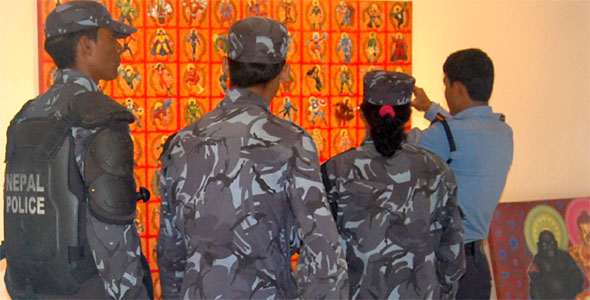
“At first, I thought it was a bit funny and I was trying to explain my works to the men from World Hindu Federation,” narrated Harijan, three weeks after the incident. “But when they said that they would burn my paintings and mentioned M F Husain, I realized that they were serious. That’s when I got scared and decided to back off.”
The group of men was led by executive board member of WHF and former Colonel of Nepal Army, Hem Bahadur Karki. It was around mid-afternoon when they arrived. At that time, Harijan was discussing his works with fellow Nepali artist, Jupiter Pradhan. “Had I been alone in the gallery, they would have beaten me up,” said Harijan, describing the then tense atmosphere and still feeling uneasy about it. It was later known, through the Gallery’s staff, that the men had been visiting the Gallery and taking pictures of the paintings since the past few days.
Although security was eventually arranged for him, Harijan stayed at different places for two weeks before moving back to his rented space, where he lives by himself. He also switched off his cell phone for a week and avoided all media attention.
The youngest of eight siblings, Harijan comes from a village in the western part of Nepal. He moved to Kathmandu in 2005 and enrolled at the Lalit Kala Campus (Fine Arts Campus) in the intermediate level. After two years, he joined Kathmandu University Center for Arts & Design (KUarts) from where he graduated with a Bachelors of Fine Arts degree in 2011. Currently, he works as an art teacher at Kendriya Vidyalaya, a school run by the Embassy of India in Kathmandu. Harijan’s sisters are in the village and his brothers, who are working in the Gulf, are all unaware of the incident.
A religious attack?
The Rise of the Collateral is a series of works made as part of the residency he was awarded by Kathmandu Contemporary Arts Centre (KCAC) in September 2011. The centre has been providing residency grants to local and visiting artists since 2009 and Director Thapa is a co-founder of KCAC.
Harijan received Nepalese Rupees 30,000 (approximately 365 US dollars) for the eight-month long program, unlike accusations made by WHF that Harijan was a ‘Dalit Christian’ who had been paid by Department for International Department (DFID) of the UK government to make sacrilegious paintings.
‘Harijan’ as a caste belongs to the Dalit group in Nepal, who were traditionally considered untouchables. Assumptions were, therefore, also made that his paintings expressed his suppressed anger towards the Hindu caste system.
While one local writer turned the incident into a caste-based issue, Harijan rebuked, “I grew up in a very broadminded community, where I never experienced any discrimination. I identify foremost as an artist and that’s how I would like to remain.”
More importantly, Harijan also identifies as a Hindu and this plays a crucial role in the content of his works.
“I draw inspirations from my own culture and religion,” Harijan stated. “These paintings collectively comment and question the influences of the West on our culture. It is a combination and therefore, collateral of the East and the West.”
When the DAO locked the gallery on 11 September, it was still unknown what WHF had exactly found offensive in Harijan’s works. Later it was revealed that a complaint against Harijan, Siddhartha Art Gallery and KCAC had been officially filed at the DAO on 7 September by a woman named Sindhu Pathak, a WHF member. Pathak had filed a request to the DAO to close the exhibition; to seize the offensive paintings; to investigate the artist, the gallery and KCAC; and to punish them as per the law.
The two page complaint outlines a total of six paintings as offensive – ‘Super Natraj’, ‘Super Kali’, ‘God creates us, god loves us’, ‘Upside down mountain’, ‘Real Buddha’, ‘108 Gods’ and ‘Captain America playing with Bhairab.’
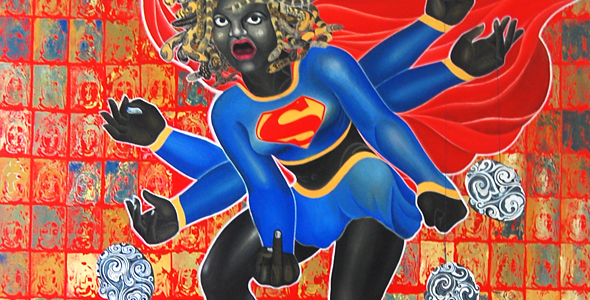
Among the most talked about work is Super Kali. The painting depicts a female figure in black with multiple hands and snakes for hair. She wears a superwoman costume and shows a middle finger. Pathak’s complain stated that Super Kali was a vulgar work which insulted all women and Goddess Kali, especially because of the middle finger which is a ‘form of the male sexual organ’.
“It was never my intention to insult or disrespect anyone through my paintings. People have misinterpreted my paintings and once they understand the actual meaning, they will not find it offensive, shocking or extreme,” reiterated Harijan.
“We live in a patriarchal society where women face various discriminations,” explained Harijan in a statement of his artworks submitted to the DAO. “The painting is about the rise of feminine energy against such discriminations. It brings together our traditional symbol of feminine power, Goddess Kali, with the Western world’s symbol of super natural power.”
Super Kali represents an urban Nepali woman in the mixed forms of Goddess Kali (East) and Superwoman (West). It is not Goddess Kali being represented as a Super Woman or vice versa, as has been the understanding.
Hundreds of Hindu temples and shrines, big and small, in Kathmandu have explicit sculptures and paintings of gods and goddesses in sexual union. They’ve been a part of our religion and culture since centuries. “If art is going to be banned then what about our traditional religious works? How do you define vulgar? Where and how can you draw a line?” questioned artist Ashmina Ranjit, at one of the gatherings campaigning for the freedom of expression.
In response to the call for ban of Harijan’s painting, a Facebook group titled ‘Let’s Censor ART’ was created by Nepali artists. People posted images of traditional sculptures and paintings that were ‘censored’ by digitally adding clothes to them.
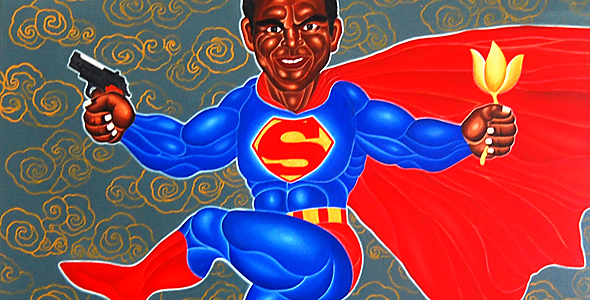
Similarly, Super Natraj shows an ordinary man, emulating the posture of Natraj – Lord Shiva in the form of a cosmic dancer – in Superman’s costume. Once again, the painting is of a man with traditional Hindu beliefs but who is also drawn towards a foreign culture. The man holds a lotus in one hand, and a gun in the other. “Each person has two sides, a violent one and a peaceful one,” Harijan put in.

Talking about super heroes, the artist revealed, “I come from a poor family and I couldn’t afford to buy comics as a child but knew about super heroes in Indian comic books.” It was only in Kathmandu that he learnt more about super heroes. In 108 Gods Harijan has painted 108 super heroes, the references for which was taken from DC and Marvel comic websites. “I have also done a simulation of Jirapat Tatsanasomboon’s painting in Captain America playing with Bhairab,” he added. Tatsanasomboon, a Thai artist, is also known for his superhero paintings.
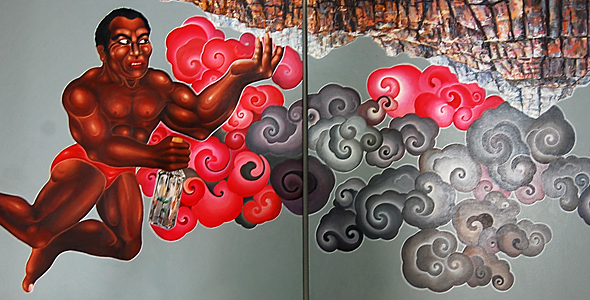
Another major painting in question was Upside down mountain. A muscular man is flying across the sky, with an upside down mountain in one hand and a bottle in the other. The narrative is derived from the Hindu epic of Ramayana in which Hanuman, a revered deity, carries an entire mountain when he can’t find the particular herb he is asked to bring.
“The mountain in my painting is upside down, barren and dry because of global warming,” said Harijan and continued, “The herb ‘Sanjivani’ is inside the bottle but many overlooked this and thought that the man was carrying a bottle of alcohol. The herb is a metaphor for amrit (nectar of immortality) that could save the world.”
‘Jeopardize harmonious relations’
Article 12 (3, a) of Nepal’s Interim Constitution guarantees every citizen the ‘freedom of opinion and expression’. However, it also states that:
‘…nothing in sub-clause (a) shall be deemed to prevent the making of laws to impose reasonable restrictions on any act which may undermine the sovereignty and integrity of Nepal, or which may jeopardize the harmonious relations subsisting among the peoples of various castes, tribes, religion or communities…’
“As much as I am allowed to express my thoughts, people are also allowed to disagree and debate. But there shouldn’t be censorship,” said Harijan. “There would be no meaning if a person can’t express himself or herself. God, the form of gods, the philosophy of religion and even super heroes – were all created by man. Why censor something that man himself created?”
“Experimentation is important for new discourses in art and in my works, I am trying to connect my culture and religion to the contemporary context,” Harijan stated and further opinioned, “The misinterpretation of my works goes to show how much of a narrow-minded society we live in.”
Regardless of wherever in the world he maybe, Harijan said that he would continue to paint similar subjects and motifs because his culture and religion will always influence and inspire his art. “Who knows, in the future, they may have an even stronger presence in my work?” he mused.
Harijan is not the first person to make references to gods and goddesses or to question Hinduism in contemporary Nepali art. Artist Asha Dangol has painted several time deities holding guns, grenades and sickles in their multiple hands. In 2009, Ragini Upadhyay Grela painted a goddess with computer wires for hair and a light bulb for her third eye as she sat atop a computer monitor instead of a lotus flower. Ashmina Ranjit has openly derided, through her performances, the discriminations Hindu women face during menstruation.
Neither is Superman a new idea. Only last year itself, Laxman Karmacharya exhibited a painting that showed deity Bhairav flying across the cityscape in a superman costume. The work was titled ‘S. Bhairavman’.
There has never been such a severe attack on art and artist in Nepal due to religious issues. “Previously, artist Chandra Man Maskey had been imprisoned for ridiculing the then Rana rulers. But since then, no artist or art institution in Nepal has ever been incarcerated or investigated by the state,” informed Gallery Director Thapa.
Nonetheless, one can’t say that we haven’t had any opposition due to religious concerns. In 2010, French artist Karl Knapp’s monumental Buddha was banned from being exhibited at the Patan Durbar Square by locals of the area. Knapp’s Buddha was constructed out of recycled plastic bags collected from garbage dumps. It was a commentary on the growing pollution of the city. Locals, however, took it as an insult to Lord Buddha and their faith. Even so, the work was still exhibited at a different location and no damage was done.
A political attack?
More than the issue of religion and hurting people’s sentiments, Thapa feels that her family’s political connection maybe the foremost reason of WHF’s attack on Harijan and her Gallery.
Thapa is the daughter-in-law of former Prime Minister Surya Bahadur Thapa and her father too has been a Congress member for many years. The former PM had recently announced that their party would not accept reinstating Nepal, which became a secular Federal Democratic Republic in 2008, as a Hindu Kingdom.
“I feel that the WHF found something to further their political agenda in order to emerge as a defender of old values and faith in the changed political scenario of Nepal,” she expressed and continued, “The work happened to be in my gallery and it gave them an opportunity to politically embarrass my father and father-in-law. Lastly, Manish also happened to be a Harijan which dragged in the issue of caste.”
Peaceful protest
On the evening of September 12, artists and supporters gathered at the gallery to discuss what the incident could mean to Nepali art. Despite the tension, many agreed that it was an achievement for contemporary Nepali arts and that it should take be as an opportunity to fight for the freedom of expression.
The following morning, September 13, a peaceful protest was staged in front of the DAO, while Harijan and Thapa were in a meeting with the Chief District Officer, Chudamani Sharma.
“Unlike what we had expected, no one from WHF was present at the meeting, but in a way I think that worked to our advantage and we diffused a situation that could have been worse,” said Thapa. It was late afternoon when the two came out of the DAO’s office, announcing that the Gallery would be reopened and none of Manish’s works would be seized. It was a moment of victory for all artists.
Unfortunately, it only lasted momentarily.
Gallery closure and artist silenced
Among the five agreements made between DAO and Harijan and Thapa, are points that outline that ‘the debated paintings will not be shown in public again’ and ‘any works offending any religion will not be made or sold’ by the artist and the Gallery.
Artists, who were supporting and campaigning for the artist, the Gallery and for the freedom of expression, feel that signing the agreement was a big blow to the artist community and to contemporary Nepali arts. In a way, they feel betrayed by both Harijan and Thapa.
“Given the time and situation, I feel that I did the right thing because not signing it could have worsened the debate – it would have become political, religious as well as ethnical,” defended Thapa. “And we have all seen the kind of violence such issues have spurred in our neighboring countries India and Bangladesh. I think that artists failed to understand the larger political consequences.”
At the moment, Nepal has a Film Censor Board, there are no such other censorship boards for fields of art, literature or music. The last thing artists want is a censorship board for the arts. Artists believe that signing the document gives reasons to WHF and other groups to censor art, in the future. It appears as if the art community has given in and lost the debate.
Criticisms are now being thrown at both Harijan and Thapa as well as to the Nepal Academy of Fine Arts (NAFA), which is the government body for fine arts in Nepal. NAFA, to their own embarrassment, stayed quiet the whole time. Harijan is now staying away from the conversation altogether, while Thapa has decided to completely shut down the gallery after March 2013.
“If the artists are saying such things then why should I run the gallery?” she reasoned. This decision comes as major throwback to artist and as sad news to contemporary Nepali arts. Siddhartha Art Gallery was opened by Thapa in 1987. It is one of the oldest running galleries of Nepal and has contributed immensely to the arts.
Amidst the bewilderment, a group of artists are still going forward with their campaign for freedom of expression. “We have been already been given the freedom of expression as a part of our basic human rights and we should be able to freely exercise the right,” said artist Ranjit. “We are going to work for the awareness of our rights by holding lectures, discussions and workshops. We also need to learn how to approach such situations in the future.”
“This incident had the potential to strengthen the arts in Nepal but it has ended on a bitter note,” shared Sujan Chitrakar, who was also one of the forerunners in campaign for Harijan and the Gallery. “Shutting down the gallery just like that, after 25 years, is very childish.”
Chitrakar is also the Academic Program Coordinator at KUarts, where Harijan was his student.
“In the future, an artist should only create controversial works if he/she has the conviction to articulate what it is about,” he stated in a serious tone. “That person should be able to take responsibility of the work or should not make such works at all.”
Reproduced by permission. Copyright © 2012 Freemuse.
Kanchan G. Burathoki is an independent artist and freelance art journalist based in Kathmandu, Nepal. She has been writing on art in Nepal since 2009 and is currently the Contributing Arts Editor for Republica English Daily. She is an Art Studio graduate of Mount Holyoke College, USA.
India: Film based on Salman Rushdie book not to be screened
Indian-born filmmaker Deepa Metha’s latest film, ‘Midnight’s Children’, may never be available to Indian audiences because of the Indian government’s aversion to the film.
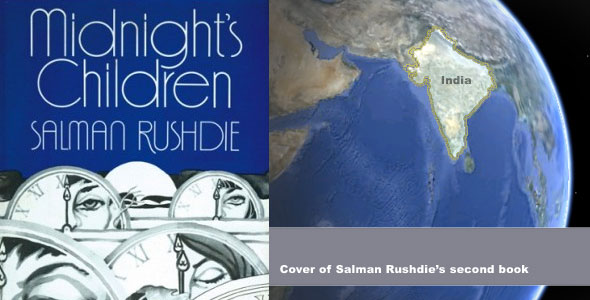
No outright ban of the film is currently in place. Instead, distributors allegedly fear soft reprisals and are avoiding the title.
The film had its debut at the Toronto International Film Festival in September 2012, and it will be screened in 40 countries around the world. But not in the nation whose ‘voice’ it represents, because no Indian distributor has shown interest in buying the rights. Some insist it’s a business decision to stay away from a niche movie that most Indians won’t see – at a time when numerous small-budget movies, including documentaries, have found takers. Others in the trade have been more honest:
“The Rushdie issue is one of the reasons why people are scared of it. Risking business is one thing, but if the threat is bigger, then people think twice,” producer and distributor Sunil Bohra told the Hindustan Times.
Self-censorship mantra
“This is censorship of a different kind: preemptive and self-imposed. No one has officially objected to the content of Midnight’s Children. There’s been nary a peep from the government, politician or organisation,” wrote Lakshmi Chaudhry of Firstpost:
“In India, we have all the visible trappings of free expression: strident and relentless criticism of the establishment, the neverending stings and scoops, the celluloid ubiquity of the venal politician. But all this shor-sharaba disguises an entrenched pusillanimity that chills the expression of dissent. In the new Indian democracy, we are ruled by the self-censorship mantra: Why make trouble when it’s bad for business. Amen, say our film distributors.”
Insecure politicians
The story is based on Salman Rushdie’s second novel, ‘Midnight’s Children’, which won the Booker Prize in 1981. It mirrors India’s history told through the emotional coming-of-age of a young man.
“What a pity if insecure politicians deprive the people of India to make up their own minds about what the film means, or does not mean, to them,” Deepa Metha was quoted as saying in the Hindustan Times.
This is not the first time that Metha has run afoul of authorities at home. Hindu right-wingers prevented her from filming ‘Water’ in the country and she shifted production to neighboring Sri Lanka where she also filmed ‘Midnight’s Children’. And Rushdie’s ‘Satanic Verses’ remains banned in India.
Hindustan Times – 8 September 2012:
Orphaned at Midnight
By Anirudh Bhattacharyya
BBC News India – 10 September 2012:
Deepa Mehta: India ‘may not see Midnight’s Children’
Firstpost – 11 September 2012:
I gag myself: Self-censoring Midnight’s Children
By Lakshmi Chaudhry
Movieline – 12 September 2012:
Deepa Metha’s Toronto Pic Midnight’s Children Effectively Banned In India
By Brian Brooks
Google News – continuously updated:
Search: “Deepa Metha” + “Midnight’s Children”
More Articles...
Page 11 of 22










